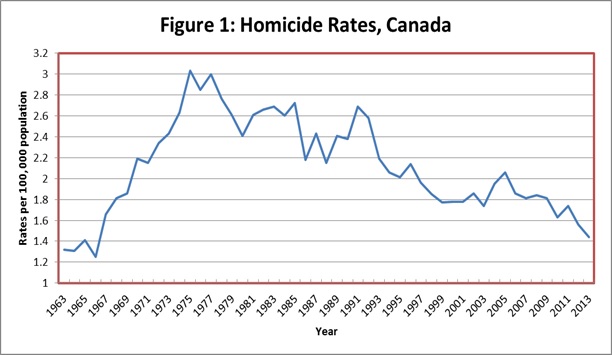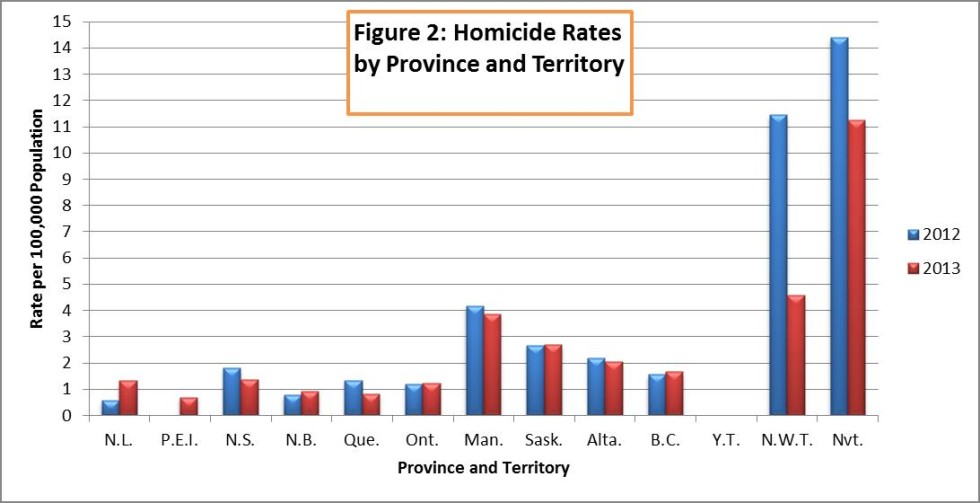By the numbers: Homicide rates in Waterloo Region
Despite homicide being a rare event in Canada, when it happens, it is the highlight of media headlines. Television news, newspapers, and social media sources all follow the story closely. In parallel to media coverage, there is a steady growth of stories being told about crime. These are found in popular novels writing about true crimes and television dramas sensationalizing the role of police and courts. With all of this attention on crime, it might be fair to imagine that consumers’ craving for violent crime related publications and or news drives its unproportioned publicity and its media focus, however, it is much more complicated to figure out which one comes first.
Homicides attract a great deal of media attention but it’s important to remember that they make up less than 1% of all violent crimes. Although homicide rates decreased last year, the homicides that did occur were heavily reported. The media focus on violent crimes, like homicide, has a great effect on the perceptions of ordinary citizens that leads to inaccurate beliefs that crime has increased. This influence of media on perceptions of crime is evident among the citizens of Waterloo Region. For instance, in the report, Won’t you be My Neighbour, the WRCPC used survey data from 2012 to show that 61% of the respondents think there is more crime Waterloo region today than when they were a child. In addition one-third of Waterloo Region residents think crime has increased over the past five years. This is despite the crime rate having dropped dramatically over the past 25 years in Canada and Waterloo Region. When news media use inflammatory language for front page headlines this can incite fear among readers and viewers and have a profound influence on the public’s perception of violent crimes including homicide.
The rate of homicide in Canada has been in steady decline since the 1980s. In 2013, there were 505 homicides in Canada, 38 homicides fewer than the previous year, marking an 8% decrease in the homicide rate (1.44 per 100,000 population). The homicide rate has generally been decreasing since peaking in the mid-1970s. (see Figure 1- homicide rates 1963 to 2013)

Source(s): Data on homicide are available back to 1961 in CANSIM table 253-0001.
Homicide, police-reported homicide rates, by province and territory, 2012 and 2013

Among the provinces of Canada, British Colombia, Ontario and Newfoundland and Labrador, saw a marginal increase in homicide numbers in 2013. On the other hand, Quebec saw 40 less homicides in 2013 than in 2012. Yukon was the only jurisdiction to report no homicides (See Figure 2). Overall, the number of homicides in Canada continued to decline as of 2013 across most provinces and territories and most census metropolitan areas.
Against this backdrop, crime in Waterloo Region in 2013 showed a one year blip where our homicide rate rose above the Canadian average. From 1981 to 2013 there were 171 homicides in the Kitchener-Cambridge-Waterloo CMA; that’s an average of 5 per year. Looking just at one year snap shots though we see the number rise to as high as 11 and drop to as low as one. A wide fluctuation like this does not mean we should panic if the rate shows a one year blip, nor should we dismiss homicides as a possibility in times when the rate drops. What’s import to examine is the trend over time, which is declining in Waterloo Region just like it is declining in Canada (Figure 3).
Homicide, police-reported rates, Canada, Kitchener/Waterloo/Cambridge – 1981 to 2013

Source: Statistics Canada, Homicide Survey, Canadian Centre for Justice Statistics.
As shown above, the rate of homicides in Waterloo Region rose above the national average in 1982, 1991, 2000, and 2013. Although the increases of the homicide rate in these four years seems alarming, in every other year, stretching 32 years of homicide rate, it was consistently lower than the national average. Waterloo Region is a safe place to live with relatively few homicides. On the other hand, although the Region has a low homicide rate, one major incident can affect the statistical rates and the publication of the event with sensational headlines could incite fear among readers and viewers and potentially trigger unfounded perceptions of crime being on the rise in our community.
What do you think is a good measure of safety in our community?
Author: Asnake Meshesha is a Master of Social Work placement student with the Waterloo Region Crime Prevention Council.
